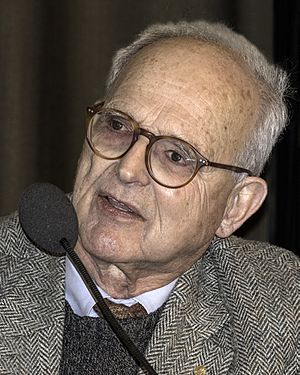Rainer Weiss facts for kids
Quick facts for kids
Rainer Weiss
|
|
|---|---|

Weiss in June 2018
|
|
| Born | September 29, 1932 |
| Education | Massachusetts Institute of Technology (BS, PhD) |
| Known for | Pioneering laser interferometric gravitational wave observation |
| Awards | Einstein Prize (2007) Special Breakthrough Prize in Fundamental Physics (2016) Gruber Prize in Cosmology (2016) Shaw Prize (2016) Kavli Prize (2016) Harvey Prize (2016) Princess of Asturias Award (2017) Nobel Prize in Physics (2017) |
| Scientific career | |
| Fields | Physics Laser physics Experimental gravitation Cosmic background measurements |
| Institutions | Massachusetts Institute of Technology Princeton University Tufts University |
| Thesis | Stark Effect and Hyperfine Structure of Hydrogen Fluoride (1962) |
| Doctoral advisor | Jerrold R. Zacharias |
| Doctoral students | Nergis Mavalvala Philip K. Chapman Rana X. Adhikari |
| Other notable students | Bruce Allen Sarah Veatch |
Rainer "Rai" Weiss (/waɪs/ wysse, German: [vaɪs]; born September 29, 1932) is a German-born American physicist, known for his contributions in gravitational physics and astrophysics. He is a professor of physics emeritus at MIT and an adjunct professor at LSU. He is best known for inventing the laser interferometric technique which is the basic operation of LIGO. He was Chair of the COBE Science Working Group.
In 2017, Weiss was awarded the Nobel Prize in Physics, along with Kip Thorne and Barry Barish, "for decisive contributions to the LIGO detector and the observation of gravitational waves".
Weiss has helped realize a number of challenging experimental tests of fundamental physics. He is a member of the Fermilab Holometer experiment, which uses a 40m laser interferometer to measure properties of space and time at quantum scale and provide Planck-precision tests of quantum holographic fluctuation.
Early life and education
Rainer Weiss was born in Berlin, Germany, the son of Gertrude Loesner and Frederick A. Weiss. His father, a physician, neurologist, and psychoanalyst, was forced out of Germany by Nazis because he was Jewish and an active member of the Communist Party. His mother, an actress, was Christian. His aunt was the sociologist Hilda Weiss.
The family fled first to Prague, but Germany's occupation of Czechoslovakia after the 1938 Munich Agreement caused them to flee again; the philanthropic Stix family of St. Louis helped them obtain visas to enter the United States. Weiss spent his youth in New York City, where he attended Columbia Grammar School. He studied at MIT, dropped out during his junior year, but eventually returned to receive his S.B. degree in 1955 and Ph.D. degree in 1962 under Jerrold Zacharias.
He taught at Tufts University from 1960 to 1962, was a postdoctoral scholar at Princeton University from 1962 to 1964, and then joined the faculty at MIT in 1964.
In a 2022 interview given to Federal University of Pará in Brazil, Weiss talks about his life and career, the memories of his childhood and youth, his undergraduate and graduate studies at MIT, and the future of gravitational waves astronomy.
Achievements
Weiss brought two fields of fundamental physics research from birth to maturity: characterization of the cosmic background radiation, and interferometric gravitational wave observation.
In 1973 he made pioneering measurements of the spectrum of the cosmic microwave background radiation, taken from a weather balloon, showing that the microwave background exhibited the thermal spectrum characteristic of the remnant radiation from the Big Bang. He later became co-founder and science advisor of the NASA Cosmic Background Explorer (COBE) satellite, which made detailed mapping of the radiation.
Weiss also pioneered the concept of using lasers for an interferometric gravitational wave detector, suggesting that the path length required for such a detector would necessitate kilometer-scale arms. He built a prototype in the 1970s, following earlier work by Robert L. Forward. He co-founded the NSF LIGO (gravitational-wave detection) project, which was based on his report "A study of a long Baseline Gravitational Wave Antenna System".
Both of these efforts couple challenges in instrument science with physics important to the understanding of the Universe.
In February 2016, he was one of the four scientists of LIGO/Virgo collaboration presenting at the press conference for the announcement that the first direct gravitational wave observation had been made in September 2015.
Honors and awards
Rainer Weiss has been recognized by numerous awards including:
- In 2006, with John C. Mather, he and the COBE team received the Gruber Prize in Cosmology.
- In 2007, with Ronald Drever, he was awarded the APS Einstein Prize for his work.
- In 2016 and 2017, for the achievement of gravitational waves detection, he received:
-
-
- The Special Breakthrough Prize in Fundamental Physics,
- Gruber Prize in Cosmology,
- Shaw Prize,
- Kavli Prize in Astrophysics
- The Harvey Prize together with Kip Thorne and Ronald Drever.
- The Smithsonian magazine's American Ingenuity Award in the Physical Science category, with Kip Thorne and Barry Barish.
- The Willis E. Lamb Award for Laser Science and Quantum Optics, 2017.
- Princess of Asturias Award (2017) (jointly with Kip Thorne and Barry Barish).
- The Nobel Prize in Physics (2017) (jointly with Kip Thorne and Barry Barish)
- Fellowship of the Norwegian Academy of Science and Letters
-
- In 2018, he was awarded the American Astronomical Society's Joseph Weber Award for Astronomical Instrumentation "for his invention of the interferometric gravitational-wave detector, which led to the first detection of long-predicted gravitational waves."
- In 2020 he was elected a Legacy Fellow of the American Astronomical Society.
Selected publications
See also
 In Spanish: Rainer Weiss para niños
In Spanish: Rainer Weiss para niños


